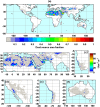Quantifying global dust devil occurrence from meteorological analyses
- PMID: 26681815
- PMCID: PMC4670712
- DOI: 10.1002/2015GL063078
Quantifying global dust devil occurrence from meteorological analyses
Abstract
Dust devils and nonrotating dusty plumes are effective uplift mechanisms for fine particles, but their contribution to the global dust budget is uncertain. By applying known bulk thermodynamic criteria to European Centre for Medium-Range Weather Forecasts (ECMWF) operational analyses, we provide the first global hourly climatology of potential dust devil and dusty plume (PDDP) occurrence. In agreement with observations, activity is highest from late morning into the afternoon. Combining PDDP frequencies with dust source maps and typical emission values gives the best estimate of global contributions of 3.4% (uncertainty 0.9-31%), 1 order of magnitude lower than the only estimate previously published. Total global hours of dust uplift by dry convection are ∼0.002% of the dust-lifting winds resolved by ECMWF, consistent with dry convection making a small contribution to global uplift. Reducing uncertainty requires better knowledge of factors controlling PDDP occurrence, source regions, and dust fluxes induced by dry convection.
Key points: Global potential dust devil occurrence quantified from meteorological analyses Climatology shows realistic diurnal cycle and geographical distribution Best estimate of global contribution of 3.4% is 10 times smaller than the previous estimate.
Keywords: climatology; dry convection; dust devils; dust emission; dusty plumes; vortices.
Figures



References
-
- Ansmann A, Tesche M, Knippertz P, Bierwirth E, Althausen D, Müller D. Schulz O. Vertical profiling of convective dust plumes in southern Morocco during SAMUM. Tellus, Ser. B. 2009;61:340–353.
-
- Balme M. Greeley R. Dust devils on Earth and Mars. Rev. Geophys. 2006;44 RG3003, doi: 10.1029/2005RG000188. - DOI
-
- Bauer P, et al. Model Cycle 38r2: Components and Performance Tech. Memo. 704. Reading, U. K: European Centre for Medium-Range Weather Forecasts (ECMWF); 2013. 58 pp.,
-
- Chomette O, Legrand M. Marticorena B. Determination of the wind speed threshold for the emission of desert dust using satellite remote sensing in the thermal infrared. J. Geophys. Res. 1999;104:31,207–31,215. doi: 10.1029/1999JD900756. - DOI
-
- Cowie SM, Knippertz P. Marsham JH. Are vegetation-related roughness changes the cause of the recent decrease in dust emission from the Sahel? Geophys. Res. Lett. 2013;40:1868–1872. doi: 10.1002/grl.50273. - DOI - PMC - PubMed
LinkOut - more resources
Full Text Sources
